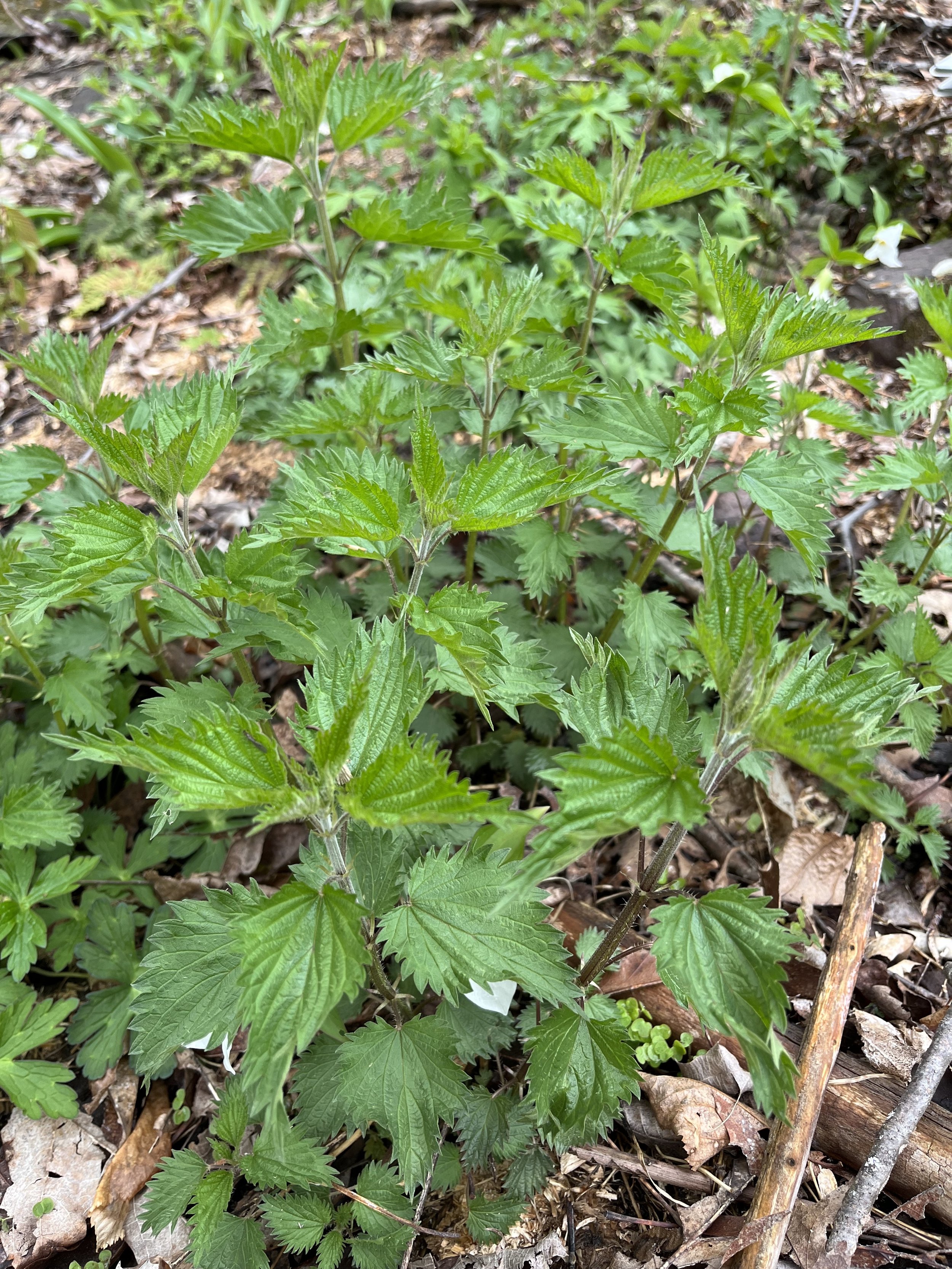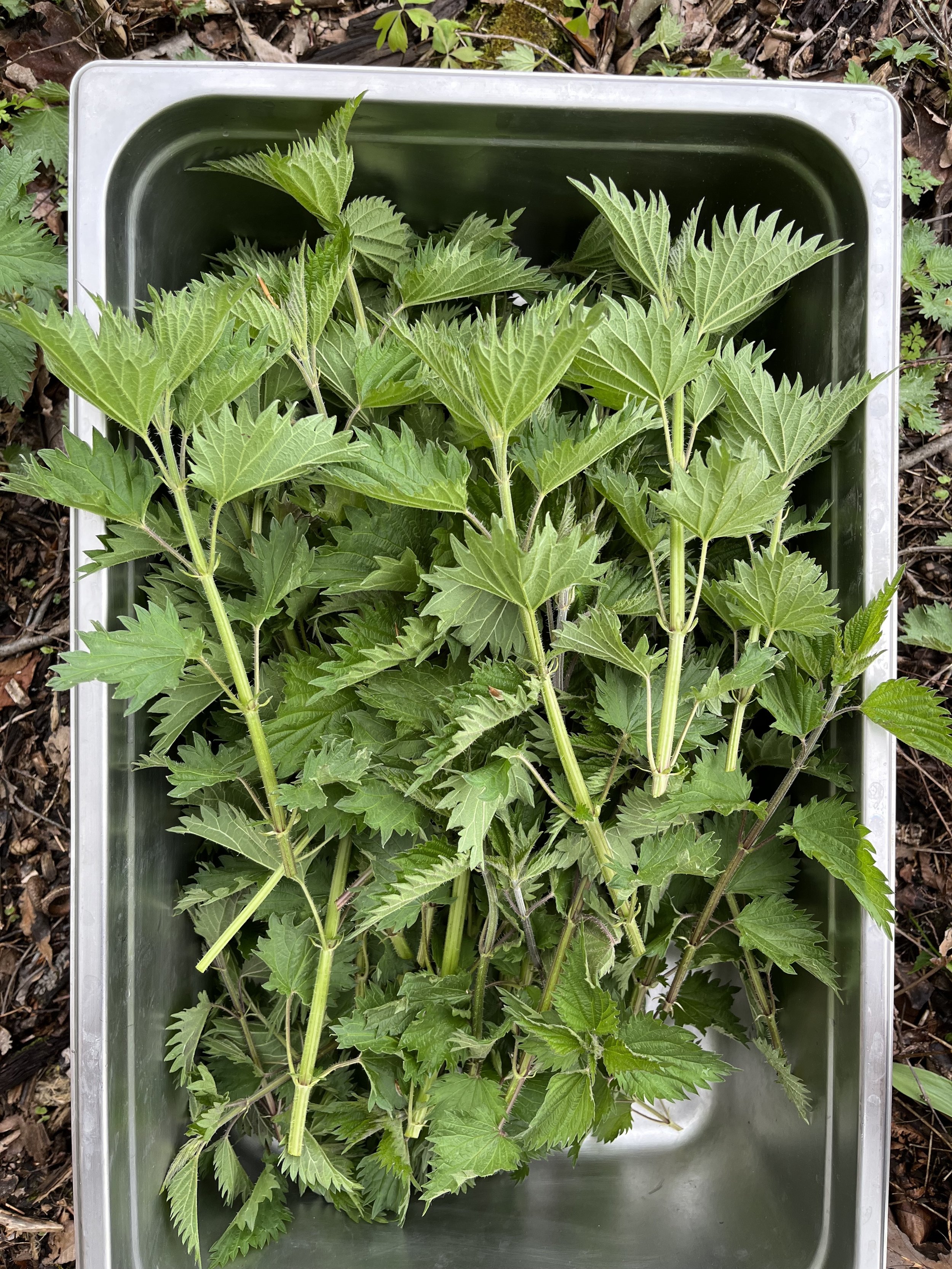Stinging Nettles
6 or more root sections/crowns for propagation
Urtica dioica
Stinging nettle is a wildly under-appreciated plant for food, medicine, and fiber. Very tough and resilient, this perennial is one of the first plants to provide edible greens in the spring. We like to blanch the young greens and eat them sauteed or in soups. Nettle greens are super nutritious and have an earthy, meaty flavor. We harvest abundant crops of greens in spring when the plants are still young. Technically you can harvest until the plants start going to seed, but we find early harvesting is best. They will recover. Whatever we can’t use fresh we dry and use for tea. This is the primary way we like to consume nettles. Our fridge is stocked with nettle tea year-round. We drink it every day!
Aside from its use as a wild edible, Stinging Nettle has so many other uses. We have used it topically for alleviating pain from a rolled ankle, we use it to make 'Fermented Plant Juice' liquid fertilizers, and this year we're retting it and making nettle fiber, which is a common use for this plant. Nettle is a dynamic accumulator, so it draws nutrients from the soil and stores them in its leaves.
We love Stinging Nettle because it is an easy-to-grow multifunctional plant that provides nutritious greens with zero effort on our part. It likes moist soil. Plant with care. Stinging Nettle is in the 'weedy' category.
You will receive at least 6 root sections and/or crowns for propagation. We are offering a combination of ‘Big Leaf Nettle’ that came originally from Oikos Tree Crops and a local wild nettle that is equally valued. Stinging nettle is very easy to plant. When we planted ours we just made the ground bare by scraping off leaf litter, put some root pieces on the ground, and covered them with composted wood chips. That being said, we would recommend burying horizontally in loosened soil or a bed and mulching generously.
6 or more root sections/crowns for propagation
Urtica dioica
Stinging nettle is a wildly under-appreciated plant for food, medicine, and fiber. Very tough and resilient, this perennial is one of the first plants to provide edible greens in the spring. We like to blanch the young greens and eat them sauteed or in soups. Nettle greens are super nutritious and have an earthy, meaty flavor. We harvest abundant crops of greens in spring when the plants are still young. Technically you can harvest until the plants start going to seed, but we find early harvesting is best. They will recover. Whatever we can’t use fresh we dry and use for tea. This is the primary way we like to consume nettles. Our fridge is stocked with nettle tea year-round. We drink it every day!
Aside from its use as a wild edible, Stinging Nettle has so many other uses. We have used it topically for alleviating pain from a rolled ankle, we use it to make 'Fermented Plant Juice' liquid fertilizers, and this year we're retting it and making nettle fiber, which is a common use for this plant. Nettle is a dynamic accumulator, so it draws nutrients from the soil and stores them in its leaves.
We love Stinging Nettle because it is an easy-to-grow multifunctional plant that provides nutritious greens with zero effort on our part. It likes moist soil. Plant with care. Stinging Nettle is in the 'weedy' category.
You will receive at least 6 root sections and/or crowns for propagation. We are offering a combination of ‘Big Leaf Nettle’ that came originally from Oikos Tree Crops and a local wild nettle that is equally valued. Stinging nettle is very easy to plant. When we planted ours we just made the ground bare by scraping off leaf litter, put some root pieces on the ground, and covered them with composted wood chips. That being said, we would recommend burying horizontally in loosened soil or a bed and mulching generously.
6 or more root sections/crowns for propagation
Urtica dioica
Stinging nettle is a wildly under-appreciated plant for food, medicine, and fiber. Very tough and resilient, this perennial is one of the first plants to provide edible greens in the spring. We like to blanch the young greens and eat them sauteed or in soups. Nettle greens are super nutritious and have an earthy, meaty flavor. We harvest abundant crops of greens in spring when the plants are still young. Technically you can harvest until the plants start going to seed, but we find early harvesting is best. They will recover. Whatever we can’t use fresh we dry and use for tea. This is the primary way we like to consume nettles. Our fridge is stocked with nettle tea year-round. We drink it every day!
Aside from its use as a wild edible, Stinging Nettle has so many other uses. We have used it topically for alleviating pain from a rolled ankle, we use it to make 'Fermented Plant Juice' liquid fertilizers, and this year we're retting it and making nettle fiber, which is a common use for this plant. Nettle is a dynamic accumulator, so it draws nutrients from the soil and stores them in its leaves.
We love Stinging Nettle because it is an easy-to-grow multifunctional plant that provides nutritious greens with zero effort on our part. It likes moist soil. Plant with care. Stinging Nettle is in the 'weedy' category.
You will receive at least 6 root sections and/or crowns for propagation. We are offering a combination of ‘Big Leaf Nettle’ that came originally from Oikos Tree Crops and a local wild nettle that is equally valued. Stinging nettle is very easy to plant. When we planted ours we just made the ground bare by scraping off leaf litter, put some root pieces on the ground, and covered them with composted wood chips. That being said, we would recommend burying horizontally in loosened soil or a bed and mulching generously.



